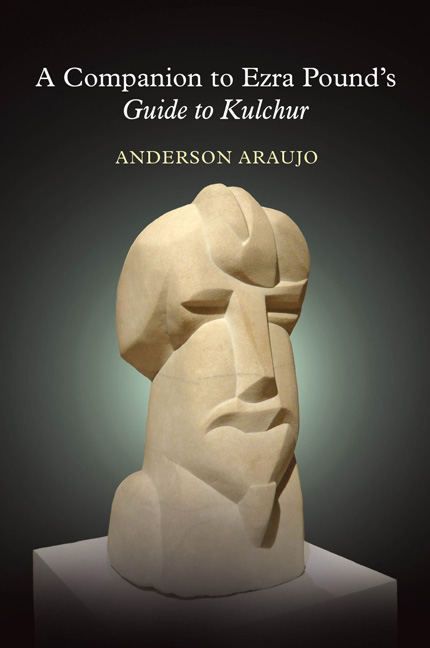Book contents
- Frontmatter
- Contents
- Acknowledgments
- Abbreviations
- Introduction
- Guide to Kulchur
- Part I
- Section I
- Section II
- 6 Vortex
- 7 Great Bass: Part One
- 8 Ici Je Teste
- 9 Tradition
- Part II
- Section III
- Section IV
- Part III
- Section V
- Section VI
- Part IV
- Section VII
- Section VIII
- Section IV
- Part V
- Section X
- Section XI
- Part VI
- Section XII
- Section XIII
- Addenda: 1952
- Notes
- Index
6 - Vortex
from Section II
- Frontmatter
- Contents
- Acknowledgments
- Abbreviations
- Introduction
- Guide to Kulchur
- Part I
- Section I
- Section II
- 6 Vortex
- 7 Great Bass: Part One
- 8 Ici Je Teste
- 9 Tradition
- Part II
- Section III
- Section IV
- Part III
- Section V
- Section VI
- Part IV
- Section VII
- Section VIII
- Section IV
- Part V
- Section X
- Section XI
- Part VI
- Section XII
- Section XIII
- Addenda: 1952
- Notes
- Index
Summary
VORTEX: Pound reprints verbatim Gaudier-Brzeska's original essay published in the first issue of the London literary magazine Blast (1914–15), the mouthpiece for Vorticism. The painter and writer Wyndham Lewis (1882–1957) edited the only two issues of the magazine. Pound's only variation on the original text here is to change most of the font, originally in all caps, to italics. Missing from the essay is the iconic image of a cone intersected by a vertical line, which appears at the end of the original piece to symbolize the creative vortex propounded by the Vorticists. Gaudier-Brzeska's essay is the last piece in the inaugural issue of Blast and functions as its manifestic core. The essay follows a contribution by Pound, also titled “Vortex.” Significant in its own right, Pound's essay prefaces the aesthetic and art-historical foundations of Gaudier-Brzeska's transhistorical and impressionistic sketch of sculpture. “All experience rushes into this vortex,” Pound proclaims, “All the energized past, all the past that is living and worthy to live.” Above all, he presents what is arguably his most seminal statement on Vorticism as a movement that concerns itself primarily with the visual arts. First published in Poetry in March 1913, the maxim reads, “An ‘Image’ is that which presents an intellectual and emotional complex in an instant of time.” Likely with Gaudier-Brzeska in mind, Pound affirms that “every concept, every emotion presents itself to the vivid consciousness in some primary form,” with “form or design in three planes” assigned to sculpture. Pound reprints the French sculptor's Vorticist manifesto as a benchmark of “real knowledge” (GK 70). Gaudier-Brzeska's elemental, hieratic sculptures embed “primary form,” combining variety and expressive experimentation. These sculptural compositions underwrite what Miranda Hickman aptly calls “the signature geometric idiom of Vorticism.” Pound supported the young artist with more than mere praise. In a December 1913 letter to William Carlos Williams, he reveals that he has “just bought two statuettes from the coming sculptor, Gaudier-Brzeska.
- Type
- Chapter
- Information
- A Companion to Ezra Pound's Guide to KulcherGuide to Kulcher, pp. 92 - 102Publisher: Liverpool University PressPrint publication year: 2018

